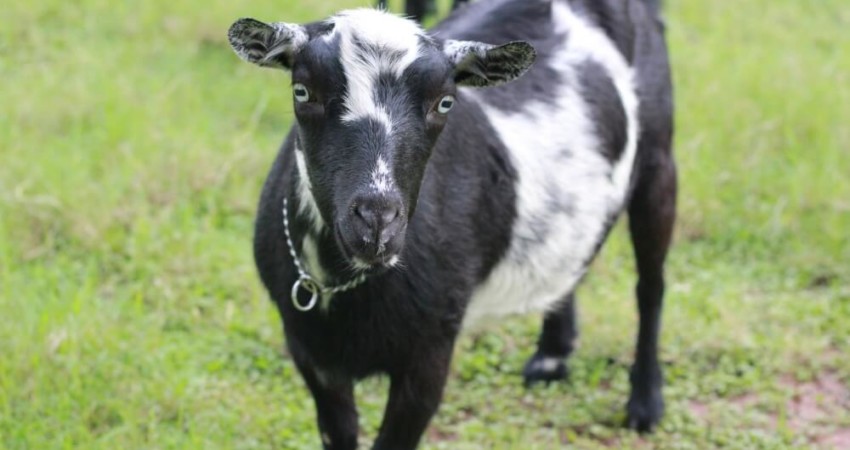

The most important part of owning goats is keeping them healthy, and the best way to do this is to examine them regularly and act fast when you see a problem developing. Look at each goat at least twice a day—during feeding time—searching for any change in routine or sign of illness or injury. This includes the eyes. While eye infections in goats are common, they are generally easy to treat and, if caught early, leave no lasting problems.
To determine whether you’re dealing with eye infections or other eye problems, look for squinting, wateriness or crustiness, cloudiness, hair loss, redness or swelling in or around the eye. Other more subtle indicators of an eye problem include holding its head abnormally, walking into things, or a hesitance to walk through a gate, door or other areas. If you notice a problem from a distance, examine that animal more closely. Despite frequent checking, any goat owner will invariably find that one of their goats has developed an eye problem.
Goats have three eyelids that protect their eyes. The upper and lower eyelids can be closed to provide protection from harsh environmental factors. Their movement over the eye also helps keep it moistened by tears and also helps manage light entering the eye. The third eyelid is also known as the “nictitating membrane.” The purpose of the third eyelid is to further protect and lubricate the eye. It contains tear glands and closes in sync with the other eyelids. Tears also protect the eyes and even contain immunoglobulins, which undoubtedly help to prevent eye infection in goats.
Common eye problems in goats.
Entropion (or inverted eyelids) is a condition in which the eyelid—usually the lower eyelid—is turned inward. It is usually found in baby goats that are one to two weeks old. In some cases, both eyes are affected. Entropion causes the lashes to rub on the eye and cause watering, irritation, and damage to the eye, if not corrected.
While known to be genetic in some sheep breeds, entropion can also be caused by too much exposure to heat lamps or ultraviolet radiation. Goat breeders who encounter cases of neonatal entropion in their animals may want to consider not keeping those kids for breeding.
The first signs of entropion include watery eye(s), cloudiness of the eye(s) and, in some cases, it may even lead to blindness. Closely examining the eyes of young kids—particularly if they show signs of excessive tears—will help with getting early intervention and avoiding blindness or other eye damage.
A veterinarian can often treat entropion by injecting 1 cc to 2 ccs of procaine penicillin under the skin of the eyelid. This is slowly absorbed, causing the eyelid to swell and pull the eyelid out so the lashes no longer irritate the eye. This procedure is not recommended for the goat owner with no veterinary training.
In more difficult cases of entropion, the veterinarian will need to suture or staple the eyelid into proper position. Finally, in the most severe cases, surgery is needed. However, this condition is uncommon in goats.
Pinkeye (also called infectious keratoconjunctivitis) is a common problem in goats. It is an inflammation of the eye that may have a variety of causes, including irritation, which can lead to eye infection in goats. Irritants can include entropion, hay dust, bright light, or wind (often occurring during transport), among others. Once the eye is infected, flies or secretions from the eye can contaminate hay and bedding, leading to an outbreak of pinkeye among the herd. This is why it is more common after goat shows, when the animals are exposed to other unrelated goats and come into contact with common irritants.
The most common bacteria that cause eye infections in goats in the United States are mycoplasma and chlamydophila, according to Goat Medicine, although other agents can also be implicated. Some goats can be carriers of mycoplasma, with no apparent problem. Others will have a mild form of infection that lasts only about 10 days, or a more severe type that also affects other parts of the body, such as the udder or the joints.
Treatment of pinkeye includes washing the eye with sterile saline (the same as used for contact lens washing) and then application of antibiotic drops or ointment, such as Terramycin eye ointment, several times a day until after the eye is improved. Some people have reported success treating with drops of Port wine or antibiotic injectable such as oxytetracycline two to three times a day. In more severe cases, a veterinarian will be needed to prescribe steroids, when no ulcers are present, or to perform surgery.
Another condition affecting goats’ eyes is inflammation of the eyelids or blepharitis. It can have a variety of causes, including mite infestations that include the eyelids, fungus, bacteria, zinc deficiency or even pinkeye that has spread to that tissue. It may even be a combination of several of these problems, for example, a mite infestation that has led to bacterial eye infection in goats. Treatment for blepharitis will depend on the cause.
Tumors can occur on the eyelids or even behind the eye. Many eyelid tumors are not cancerous, do not grow beyond a limited size and are nothing to be concerned about. Those that continue to grow or seem to be spreading, or appear along with other tumors, should be investigated by a veterinarian. They may be removed surgically with a good outcome if the owner is willing to make that expenditure. Papillomavirus can also cause wart like growths on the eyelids.
Tumors behind the eye or in the nasal cavity are not common but are of serious concern. They can cause the eye to protrude abnormally and are usually found upon inspection of the eye by a vet.
 Contact Jaguza Support
Contact Jaguza Support